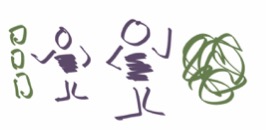When we reflect on a complex event, it often looks predictable in hindsight and this makes it harder to deal with complexity in the future. This post is about complexity in the Cynefin sense – where it is not possible to see linkages between events beforehand – but it is possible to see those linkages afterwards.
The two Cynefin domains that have high certainty are called Complicated and Obvious. The complex events that happened in the past – look like they belong in these domains – when facilitating sessions with people and asking if the past events were predictable, they will often say that they were. It is a good idea to double-check that this is the case – ‘are you saying they were predictable with your benefit of hindsight? Or if we went back in time, is it really an unpredictable set of linkages?’
It is useful to take examples of past events and create a Cynefin Framework from them in order to create a shared understanding among a group of people. The Cognitive Edge Method to do this is called 4-points or 4-tables contextualisation. Once the Cynefin Framework has been created, the labels on the groupings of events become very useful in the future. The group can then say that an upcoming event is like one in the framework, and if it is in the Complex Domain, use an exploratory approach rather than a project management method more suited to the Complicated Domain.
The main ‘gotcha’ with using historical events is this one – that the complex ones do not appear complex in hindsight – so be careful when facilitating that this is not a factor – otherwise, the Cynefin Framework created will have more examples of high-certainty events than actually exist in the environment.

